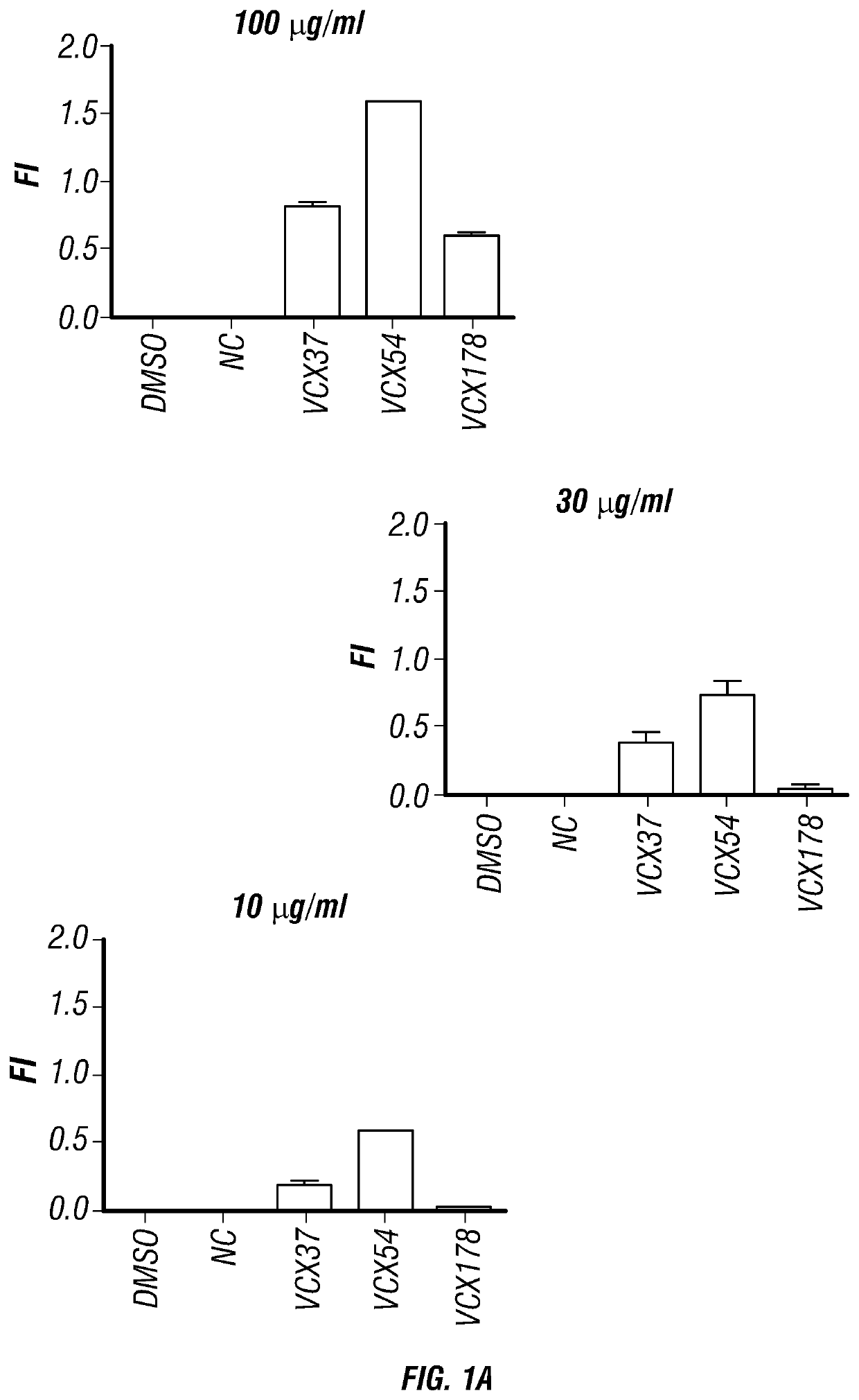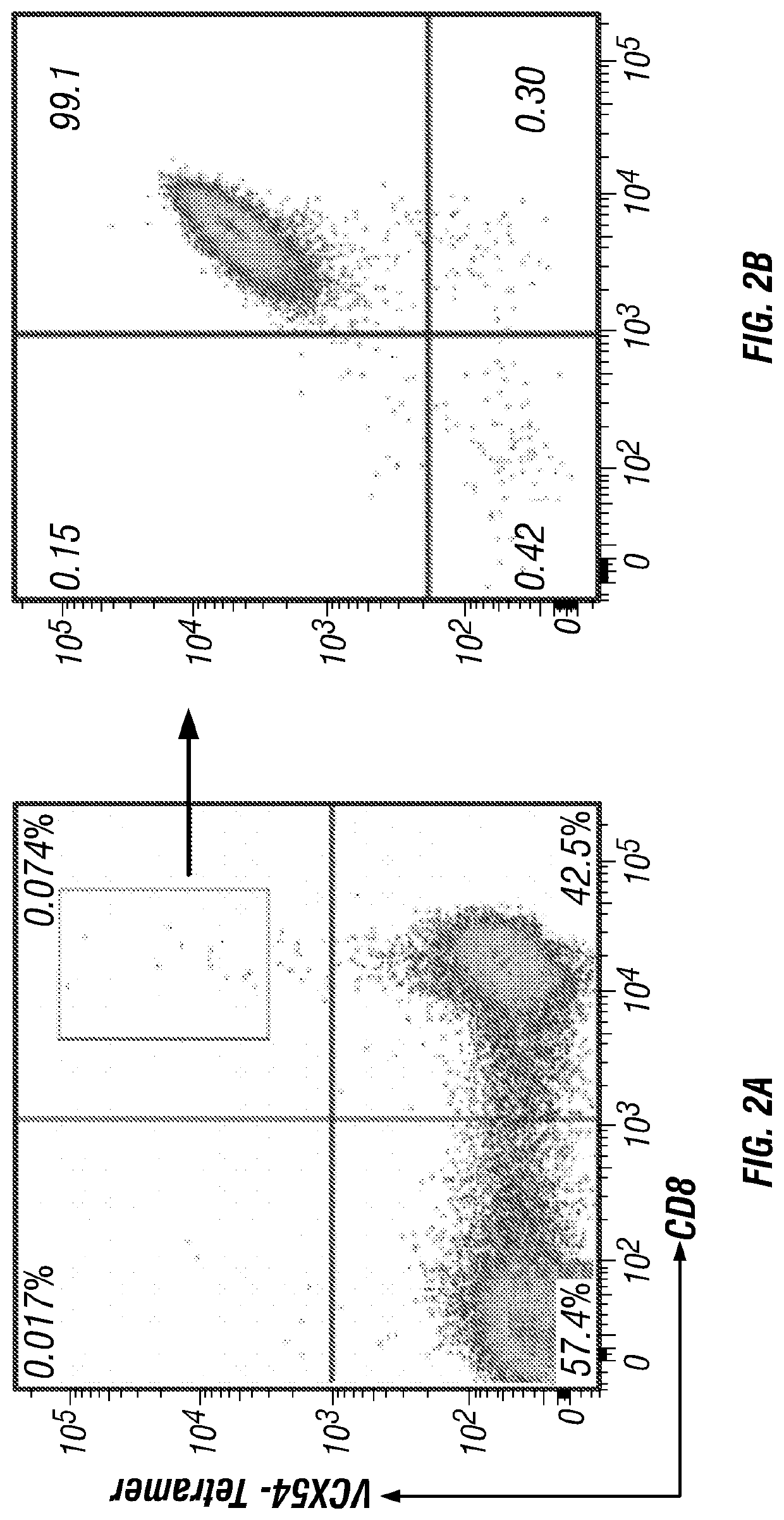Hla-restricted vcx/y peptides and t cell receptors and use thereof
a peptide and receptor technology, applied in the field of immunology and medicine, can solve the problems of toxicity to non-cancerous tissues, lack of immunogenic antigen targets, and inability to reach patients, so as to reduce the chance of getting or relapsing
- Summary
- Abstract
- Description
- Claims
- Application Information
AI Technical Summary
Benefits of technology
Problems solved by technology
Method used
Image
Examples
example 1
ation and Characterization of Tumor Antigen-Specific Peptides
[0214]Epitope prediction tools including BIMAS, SYFPEITHI and NetMHC analysis were used to predict HLA-restricted peptide epitopes for the VCX3A antigen. The results of the VCX3A binding and affinity prediction are depicted in Table 1.
TABLE 1HLA-A*0201 peptide of VCX3A binding and affinityprediction.NetMHCBIMASSYFPEITHIaffinityPeptidescorescorepredictionKVAKKGKAV (37) (SEQ21.31810442.93 nMID NO: 8)GAATKMAAV (54) (SEQ 2.2221 3260.85 nMID NO: 1)SEMEELPSV (178) (SEQ 47.18722 495.92 nMID NO: 9)
[0215]The predicted peptides were synthesized and co-cultured with T2 cells with a series of diluted concentrations. DMSO without peptide or with the same concentration of negative binding to HLA-A2 peptide were used as control. After 18 hr incubation, the HLA-A2 expression was detected by flow cytometer. The fluorescence index (FI) was calculated as follows: FI=(mean fluorescence with the given peptide−mean fluorescence without pepti...
example 2
n and Evaluation of VCX54 Specific T Cell Receptor
[0221]The T cell receptor of the VCX54 clone C7 of Example 1 was subjected to usage and sequence analysis. Using PCR identification and flow cytometry, the TCR alpha chain (TRAY) TRAV-14 and TCR beta chain (TRBV) TRBV-13 were analyzed (FIG. 7). The TRAV-14 CDR3 amino acid sequence was determined to be CAMITSGNTGKLIF (SEQ ID NO:2) and the TRBV-13 CDR3 amino acid sequence was determined to be CASSPPGGGRTEAFF (SEQ ID NO:3) (FIG. 8).
[0222]The TCR from the VCX54 CTL C7 clone was constructed into the retrovirus expression vector pMSGV1. A linker fragment containing a Furin cleavage site, a SGSG linker and a P2A cleavage site was inserted between the TCR-β chain and TCR-α chain to guarantee that both chain were expressed equally under the MSCV promoter (FIG. 9). The retrovirus expression vector pMSGV1 comprising the TCR sequence from the VCX54 CTL clone and an envelop vector RD114 were co-transfected into the package cell line GP2-293. Two ...
example 3
and Methods
[0230]Generation and Expansion of VCX54-Specific CD8 T Cells:
[0231]Tumor antigen-specific CTLs were generated with a manner previously described (Li 2005). Leukapheresis PBMCs positive for HLA-A*0201 were stimulated by autologous DC pulsed with tumor antigen peptide. For induction of dendritic cell, adherent PBMCs were cultured with GM-CSF and IL-4 in AIM-V medium (Invitrogen Life Technologies) for 6 days and then added IL-1β, IL-6, TNF-α and PGE2 for maturation. After 1 day, mature DCs were pulsed with 40 μg / ml peptide at 2×106 cells / ml of 1% human serum albumin (HSA) / PBS in the present of 3 μg / ml beta-microglobulin for 4 hr at room temperature. After washing with 1% HSA / PBS, DCs were mixed with PBMCs at 1.5×106 cell / ml / well in 48 well plate. IL-21 (30 ng / ml) was added initially and 3˜4 days after culture. IL-2 and IL-7 were added 1 day after secondary stimulation to expand activated antigen-specific T cells.
[0232]6 days after secondary stimulation, cells were stained wi...
PUM
| Property | Measurement | Unit |
|---|---|---|
| time | aaaaa | aaaaa |
| diameter | aaaaa | aaaaa |
| concentration | aaaaa | aaaaa |
Abstract
Description
Claims
Application Information
 Login to View More
Login to View More - R&D
- Intellectual Property
- Life Sciences
- Materials
- Tech Scout
- Unparalleled Data Quality
- Higher Quality Content
- 60% Fewer Hallucinations
Browse by: Latest US Patents, China's latest patents, Technical Efficacy Thesaurus, Application Domain, Technology Topic, Popular Technical Reports.
© 2025 PatSnap. All rights reserved.Legal|Privacy policy|Modern Slavery Act Transparency Statement|Sitemap|About US| Contact US: help@patsnap.com



